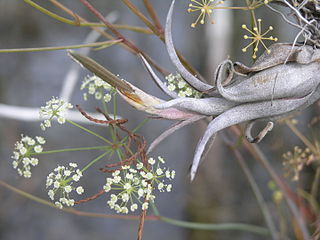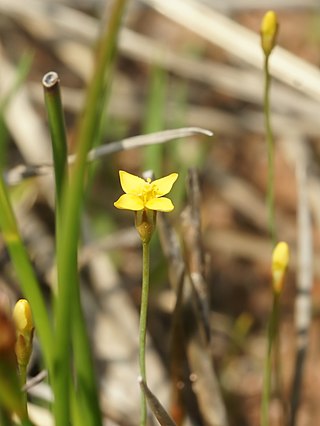
Phaseolus is a genus of herbaceous to woody annual and perennial vines in the family Fabaceae containing about 70 plant species, all native to the Americas, primarily Mesoamerica.

Flammulina filiformis is a species of agaric in the family Physalacriaceae. It is widely cultivated in East Asia, and well known for its role in Japanese and Chinese cuisine. Until recently, the species was considered to be conspecific with the European Flammulina velutipes, but DNA sequencing has shown that the two are distinct.

The Potamogetonaceae, commonly referred to as the pondweed family, is an aquatic family of monocotyledonous flowering plants. The roughly 110 known species are divided over six genera. The largest genus in the family by far is Potamogeton, which contains about 100 species.

Persicaria filiformis is a species of flowering plant in the family Polygonaceae, native to the Kuril Islands, Japan, Korea, Myanmar, the Philippines and Vietnam. It was first described as Polygonum filiforme in 1784 by Carl Thunberg and transferred to the genus Persicaria in 1819 by Takenoshin Nakai. The species has been treated as the variety filiformis of Persicaria virginiana, a North American species.

Stuckenia pectinata, commonly called sago pondweed or fennel pondweed, and sometimes called ribbon weed, is a cosmopolitan water plant species that grows in fresh and brackish water on all continents except Antarctica.

Lachnagrostis filiformis is a species of grass known by the common names Pacific bent grass, New Zealand wind grass, fairy grass, or blown-grass. It is native to Australia, New Zealand, and other Pacific Islands including New Guinea and Easter Island. While it is found in a wide variety of habitats, it seems particularly invasive in areas with damp soils, such as areas near bodies of water. It has been introduced to southern Africa, the United Kingdom, Taiwan, the southern United States and Mexico.

Pholiurus is a genus of Eurasian plants in the grass family. The only known species is Pholiurus pannonicus, found in a region stretching from Austria to Kazakhstan.
Reynaudia is a genus of plants in the grass family. The only known species is Reynaudia filiformis, native to the Greater Antilles.
Ophiuros is a genus of Asia, Australian, and East African plants in the grass family.

Penstemon filiformis is an uncommon species of Penstemon known by the common name threadleaf beardtongue. It is endemic to the Klamath Mountains of northern California, where it grows in forest and woodland, often on serpentine soils. It is a perennial herb growing up to half a meter tall, its stem hairy and woody toward the base. The leaves are very narrow, linear and rolled to threadlike, reaching up to 7 centimeters long, those low on the plant sometimes borne in clusters. The inflorescence produces hairless, tubular or funnel-shaped blue to purple flowers just over a centimeter in length.
Stuckenia striata is a species of aquatic plant known by the common names broadleaf pondweedNevada pondweed and striped pondweed. It is native to the Americas, including the southwestern United States, northern Mexico, and parts of Central and South America. It grows in waterways such as rivers, canals, and shallow ponds, often in alkaline water. This is a perennial herb producing a long, thin, branching stem approaching 2 m in maximum length. The narrow, hairlike leaves are up to 10 cm (3.9 in) long and only a few millimeters wide. The inflorescence is a spike of flowers arranged in whorls and borne on a short peduncle.

Cassytha filiformis or love-vine is an orangish, wiry, parasitic vine in the family Lauraceae. It is found in coastal forests of warm tropical regions worldwide including the Americas, Indomalaya, Australasia, Polynesia and tropical Africa.

Stuckenia is a genus of flowering aquatic plants. It contains approximately 30 species that grow in shallow water. Pondweed is a common name for plants in this genus.

Stuckenia vaginata, commonly called sheathed pondweed, big sheathed pondweed or large-sheathed pondweed is a water plant species that grows in fresh and brackish water in Europe, Northern Asia and North America. Sheathed pondweed is rare, but is not in the 2012 IUCN Red List.

Persoonia filiformis is a species of flowering plant in the family Proteaceae and is endemic to the south-west of Western Australia. It is a small, erect shrub with hairy young branchlets, linear leaves and greenish yellow flowers borne singly or in groups of up to twenty on a rachis up to 30 mm (1.2 in) long.

Tiedemannia filiformis is a species of flowering plant in the carrot family known by the common names water cowbane and water dropwort. It grows in swamps, freshwater wetlands, and along the borders of ponds in the southeastern United States, as far north as Delaware, as well as the northern Bahamian pineyards of the Bahamas.
The Mellandsvågen Nature Reserve is located on the western part of Skardsøya island in the municipality of Aure in Møre og Romsdal county, Norway. Since 1996, the nature reserve has had the status of a Ramsar site because of its importance for migratory birds.

Cicendia filiformis, also called yellow centaury or slender cicendia, is a species of flowering planet of the family Gentianaceae.

Juncus filiformis, called the thread rush, is a species of flowering plant in the genus Juncus, with a circumboreal distribution. It has been introduced to South Georgia Island. It is typically found in wetlands, on the borders of lakes and streams.
Parapholis filiformis is a species of annual herb in the family Poaceae. They have a self-supporting growth form and simple, broad leaves. Individuals can grow to 0.17 m.














